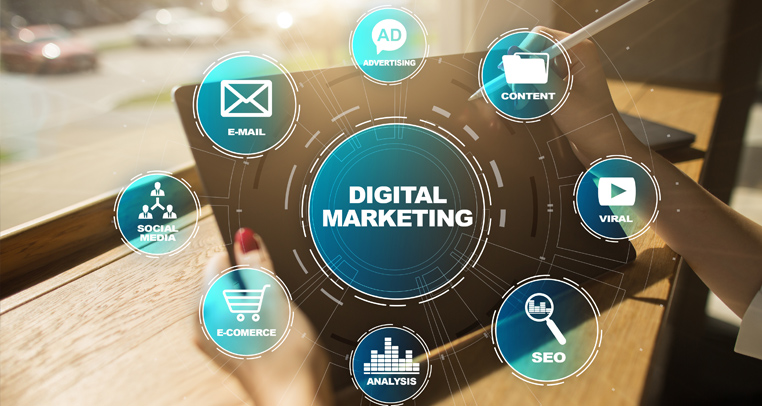Each day, millions of consumers and businesses across the globe use their smartphones, tablets, and laptops to make critical purchasing decisions. Reaching these prospective buyers online has become a new science within marketing—digital marketing.
If you’re not familiar with digital marketing or are new to the field, you may find some of the terminology confusing. To help you get a clearer picture of the digital marketing universe and its dynamics, we’ve assembled this handy, quick-reference glossary of 21 common digital marketing terms you should know.
A/B Testing
Also known as “split testing,” A/B testing allows marketers to compare viewer reactions to two versions of a website to determine which version performs better. Variables that differ between A & B versions may include content, graphic design elements, or site navigation tools.
Backlink
Also called “inbound” or incoming links” backlinks provide a link from an outside domain that leads to your domain.
Bounce Rate
The bounce rate refers to the number of people who visit a site but do not click on any other content pages on the site before leaving.
Click-Through Rate
In contrast to the bounce rate, the click-through reflects the number of people who visit a site and do click through to other pages on the site.
Content Marketing/ Social Media
In the context of social media marketing, content marketing attempts to use relevant and interesting content to encourage potential consumers to engage with a client’s brand. Shared material may include articles, blogs, videos, Twitter or Facebook posts, Instagram stories, and more.
Conversion Rate
The conversion rate reflects the number of closed sales (conversions) relative to site visits and click-throughs. Each site visitor who becomes a customer represents a conversion.
CTA
CTA (or “call to action”) is an invitation for the consumer to engage with the brand. CTAs can be found in websites, space ads, or mobile/web ads. Common calls to action include, “Contact us today!” or “Call now!”
Digital Marketing
Digital marketing represents the science and business of connecting online brands with potential digital consumers. Techniques include social media marketing (using platforms such as Facebook, Twitter, and Instagram), display ads, email marketing, and pay-per-click advertising.
Display Ad
A print or web advertisement, usually of specific dimensions (e.g., banner, sidebar, half-page) and often sold on a contract basis.
Email Marketing
In the digital marketing world, email has become a useful tool to help brands reach potential customers. Email marketing tools may be part of an overall digital marketing strategy and may also alert consumers to time-sensitive offers or opportunities.
Hyperlink
Often in an article’s text, you’ll see bold or highlighted phrases. Click on one and it will take you to another site with more information about that word or phrase. Hyperlinks allow speedy and convenient navigation and reduce barriers to purchasing.
Impression
Impressions reference the number of times an ad is shown to potential consumers (regardless of what action they take). Impressions can help brands measure site traffic, and when paired with other analytics (such as bounce and click-through rates), can help guide overall digital marketing strategy.
Inbound Marketing
Inbound marketing is a method of attracting new customers by creating and posting valuable and custom-targeted content to spur consumer interest.
Keyword Search
Search engines use keywords to identify and rank relevant content. For brands, the aim is to appear nearest the top of the search rankings. By refining keywords and using SEO (see below), brands can generate more qualified leads.
Landing Page
A landing page is the first point of contact between a brand and its potential customers. It may serve as a welcome, an introduction to the brand’s ethos, and a first glimpse of the brand’s products or services. Landing pages also offer insight into to a brand’s mission, and what characteristics set it apart from the competition.
Metadata
Metadata refers to the “behind the scenes” portion of a website—the information that site visitors don’t see. Metadata may include subject tags that help visitors find the site (and boost the site’s search rankings), as well as information on file size, upload date, formatting, and more.
Pay-Per-Click Advertising
Pay-per-click (PPC) advertising is a form of marketing in which the client business initiates a marketing campaign that pays a set amount each time a visitor clicks through to specific site content to learn more or to make a purchase. PPC offers the advantage of pre-qualifying a prospective visitor’s interest, thus raising the quality of leads generated.
Remarketing/ Retargeting
If you’ve recently browsedfor camping supplies, you may find yourself the target of ads from one or more of the sites you visited—whether or not you made a purchase. This form of advertising, called remarketing or retargeting, allows brands to target consumers who’ve previously visited a site, in an attempt to generate new business.
Responsive Design
Millions of consumers make online purchases daily—some use smartphones, while others use laptops or tablets. Creating marketing campaigns that perform as well on the small screen as they do on a laptop presented a challenge to marketers. Responsive advertising answered that challenge by being able to recognize the type of device on which it’s being viewed and adapt accordingly—with no endless scrolling and no awkward line breaks.
RSS
With the volume of content on the web, it’s impossible to keep up with it all. Really Simple Syndication (or RSS) allows users to quickly scan relevant content in a paired-down, text format that’s ideal for rapid reading. Busy users can scan their feed and pursue only the content that’s most relevant or important.
SEO
Search engine optimization (SEO) is a method used by marketers to improve a brand’s ranking among search results. Optimizing for search has been shown not only to increase site traffic but to provide more qualified leads.
We hope you’ve found this glossary helpful. If you’re looking to expand you’re brand’s reach, explore emerging markets, or chart a new course to prosperity, connect with us at Click Canyon.

